Dreaming of a sun-kissed tan but wondering about the risks that come with it? Whether you're a fan of the golden rays or a regular at the local tanning salon, it's time to shed some light on the truth behind tanning.
Battle of the UV rays: tanning beds vs. the sun
The sun and tanning beds are both culprits in the UV rays department, but they each come with their own setbacks.
Natural sunlight is our daily dose of vitamin D but its damaging rays can harm your skin. UVB rays – the ones responsible for sunburn – hit the skin's surface and cause immediate damage. UVA rays penetrate deeper and contribute to long-term aging and cancer risks.
However, when fall arrives and the days grow shorter, natural sunlight becomes less effective at delivering a strong tan (and damage).
Enter the world of tanning beds: your shortcut to a bronze look without the need to bask in the sun. But here's the catch – they are the bigger UV offender.
“Tanning beds typically deliver UVA and UVB rays at levels 3 to 5 times more intense than natural sunlight,” says Beth Bialko, esthetician and Bioelements Senior Director of Education. “This heightened intensity increases the potential for skin damage and health risks.”
The risks of tanning beds
With nearly 30 million tanning enthusiasts in the U.S. each year, it’s a popular pastime, especially among women aged 16-49. However, the risks are glaring. Indoor tanning is linked to a 58% increased risk of squamous cell carcinoma and a 24% increased risk of basal cell carcinoma. Not exactly the kind of stats you want to brag about!
A 2007 study by the International Agency for Research on Cancer also found that individuals who use tanning beds before age 35 are 75% more likely to develop melanoma, the deadliest form of skin cancer. This risk escalates with each additional tanning session.
How soon can you begin to feel (and see) the dangerous effects of a tanning bed? According to Bialko, “The adverse effects of tanning beds can manifest both immediately and over time. Immediate symptoms include redness, irritation and rash, which can appear within hours to days following exposure. Long-term consequences of frequent tanning include accelerated skin aging and a heightened risk of skin cancer. Each tanning session contributes to cumulative skin damage and increases the likelihood of serious health issues.”
The concept of a "safe tan" is a misconception. Since 2003, UV radiation has been classified as a known carcinogen by the U.S. National Toxicology Program.
“Any exposure to UV rays, whether from the sun or tanning beds, damages the DNA in your skin cells,” says Bialko. “This damage not only increases the risk of skin cancer but also contributes to premature aging – including wrinkles, pigmentation and loss of skin elasticity.”
Do tanning beds help with acne?
While it might seem like a tan could be the perfect remedy for those pesky pimples, the truth is quite the opposite. The intense UV rays can actually worsen acne by increasing inflammation and redness. Plus, the heat from tanning sessions can lead to more sweating, which clogs pores and can aggravate existing breakouts. Far from being a miracle cure, tanning beds often turn your skin issues from bad to worse. If acne is a concern, it’s best to stick to proven treatments and let your skin care routine keep your complexion clear and healthy.
Tanning alternatives
Despite these staggering statistics, people continue to tan. It’s not just about the look; it’s the warmth and the endorphin rush that makes them feel good. For some, it’s like a cozy hug of happiness, even if it comes with a side of skin damage.
So, what’s a sun-loving soul to do? Embrace safer alternatives! Consider methods such as self-tanning products or professional spray tans. These options provide a safe way to achieve a bronzed look while minimizing the risks associated with UV exposure.
Remember, your skin deserves the best. Skip the burn and go for the glow with safe, skin-friendly options.
Sources: https://www.aad.org/public/diseases/skin-cancer/surprising-facts-about-indoor-tanning
https://pubmed.ncbi.nlm.nih.gov/31381131/
https://www.health.harvard.edu/staying-healthy/is-a-tanning-bed-safer-than-sunlight









































